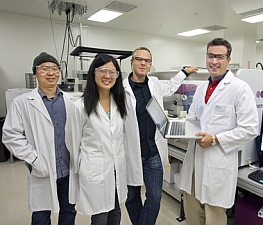
The j5 software team, L-R: Timothy Ham, Joanna Chen, Rafael Rosengarten, and Nathan Hillson (Roy Kaltschmidt/Lawrence Berkeley National Lab)
A team of researchers at Lawrence Berkeley National Laboratory in California has written a software package that they say streamlines the process of DNA construction. The software, known as j5, is available for free for non-commercial users.
DNA construction, also known as DNA cloning or recombinant DNA technology, has become a critical tool of modern biotechnology, employed in genetic studies, medical research, and the development of advanced biofuels. The use of DNA construction in biofuel research brought the need for more efficient DNA processes to the attention of Joint BioEnergy Institute (JBEI), part of the U.S. Department of Energy and an affiliate of the Berkeley Lab.
In DNA construction, multiple genes or fragments of DNA sequences are physically assembled together into structures used to develop new medical treatments and engineer microbes to efficiently carry out a specific task, such as converting cellulosic biomass into renewable transportation fuels.
The process brings together these DNA sequence fragments from a variety of organisms into a self-replicating genetic element, such as a bacterial plasmid — a non-chromosomal element, often a circular DNA — that will propagate the assembled DNA parts in a host cell. In the past, this process has required the use of various restriction enzymes for splicing desired DNA sequence fragments, and ligation enzymes for bonding the fragments to plasmid cloning sites.
Nathan Hillson, a biochemist who directs JBEI’s Synthetic Biology program, says that the increasing size and number of parts has made DNA construction increasingly more complex and difficult. “The process must often be repeated from scratch for alternate combinations of parts,” notes Hillson, “and every time you clone a different gene or fragment, you might have to use a different pair of restriction sites. This has been a labor-intensive and time-consuming process.”
But Hillson also points out that with modern DNA construction techniques, a small number of enzymes can be used over and over again, independent of the DNA sequence fragments being assembled. This ability to reuse enzymes makes it possible to automate the process using robotics. Designing protocols for these modern DNA construction approaches, however, can be as labor-intensive, time-consuming and error-prone as the traditional approach. To address these and related considerations Hillson and colleagues created the j5 software.
The j5 package is Web-based software that automatically designs and optimizes DNA construction protocols. “Within minutes it can determine the optimal flanking sequences that should be attached to each DNA part” says Hillson, “to produce the desired recombinant DNA at the least expense, in a manner that is executable by hand or robotics.”
The j5 software also makes it possible to construct combinatorial libraries — collections of hundreds to millions of related DNA assemblies, each with a different combination of genes or parts that perform similar functions in different organisms. With combinatorial libraries, scientists can select the most effective genetic combination for achieving a desired result, e.g., the most efficient production of a biofuel or medication in a given host. Hillson says no other automated DNA cloning software does this on the same scale or as fast as j5.
Some 110 institutions worldwide are now registered users of j5. The Web-based version of j5 is available to non-commercial users under a no-cost license agreement. Commercial users can access the Web-based version of j5 on a 14-day trial basis before licensing the software.
Read more: Genomic Software Offers Faster Interpretations for Diagnosis
* * *

 RSS - Posts
RSS - Posts
[…] Read more: Lab Develops Automated DNA Construction Software […]